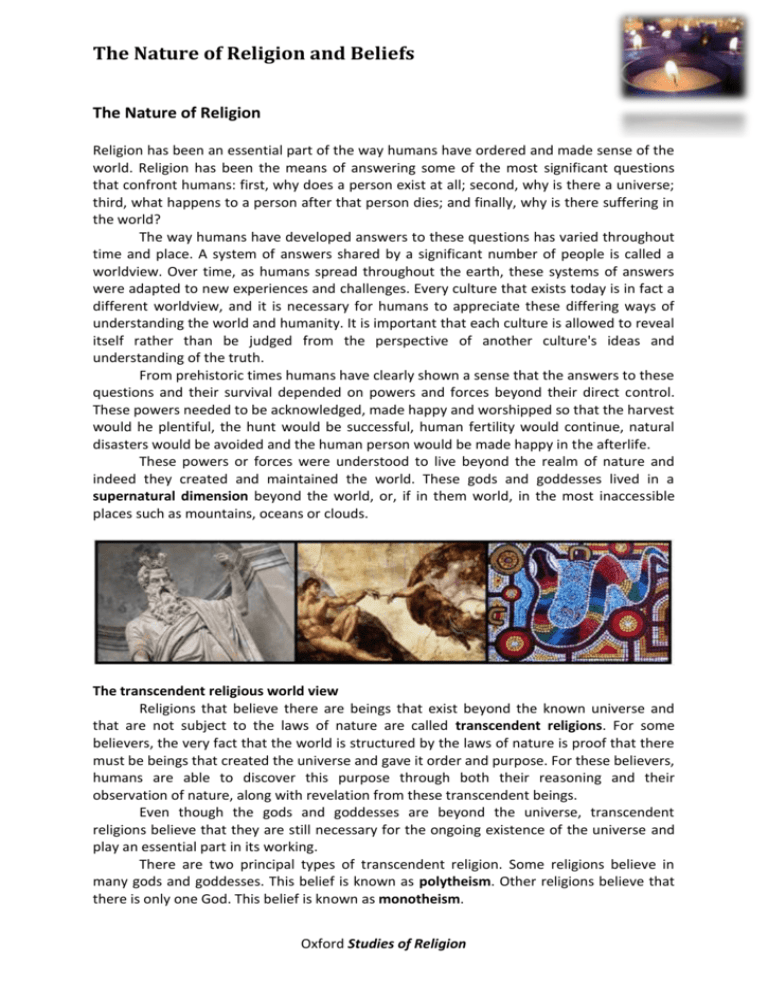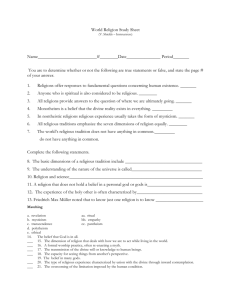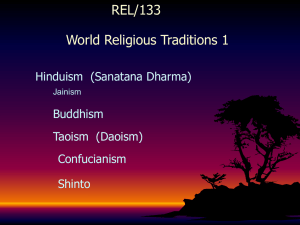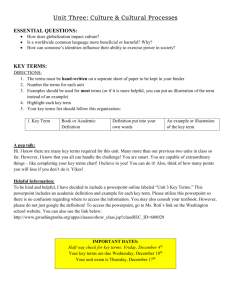1.Nature of Religion – Oxford
advertisement

The Nature of Religion and Beliefs The Nature of Religion Religion has been an essential part of the way humans have ordered and made sense of the world. Religion has been the means of answering some of the most significant questions that confront humans: first, why does a person exist at all; second, why is there a universe; third, what happens to a person after that person dies; and finally, why is there suffering in the world? The way humans have developed answers to these questions has varied throughout time and place. A system of answers shared by a significant number of people is called a worldview. Over time, as humans spread throughout the earth, these systems of answers were adapted to new experiences and challenges. Every culture that exists today is in fact a different worldview, and it is necessary for humans to appreciate these differing ways of understanding the world and humanity. It is important that each culture is allowed to reveal itself rather than be judged from the perspective of another culture's ideas and understanding of the truth. From prehistoric times humans have clearly shown a sense that the answers to these questions and their survival depended on powers and forces beyond their direct control. These powers needed to be acknowledged, made happy and worshipped so that the harvest would he plentiful, the hunt would be successful, human fertility would continue, natural disasters would be avoided and the human person would be made happy in the afterlife. These powers or forces were understood to live beyond the realm of nature and indeed they created and maintained the world. These gods and goddesses lived in a supernatural dimension beyond the world, or, if in them world, in the most inaccessible places such as mountains, oceans or clouds. The transcendent religious world view Religions that believe there are beings that exist beyond the known universe and that are not subject to the laws of nature are called transcendent religions. For some believers, the very fact that the world is structured by the laws of nature is proof that there must be beings that created the universe and gave it order and purpose. For these believers, humans are able to discover this purpose through both their reasoning and their observation of nature, along with revelation from these transcendent beings. Even though the gods and goddesses are beyond the universe, transcendent religions believe that they are still necessary for the ongoing existence of the universe and play an essential part in its working. There are two principal types of transcendent religion. Some religions believe in many gods and goddesses. This belief is known as polytheism. Other religions believe that there is only one God. This belief is known as monotheism. Oxford Studies of Religion The Nature of Religion and Beliefs Polytheistic religions For polytheistic religions, the gods and goddesses may have control of particular happenings in nature. In some religions there are gods who rule the oceans and the skies, others who look after the fertility of all animals and humans, others who protect humans from natural disasters and others who are concerned about the health and well-being of humans. Examples of polytheistic religions are Hinduism and the religion of ancient Greece. In many polytheistic religions, there are gods and goddesses who bring evil into the world in the form of natural disasters, disease, and loss of possessions and life itself. These gods require particular attention, for they will only stop harming humans if they are made happy through worship and sacrifice. Humans have a special relationship with these gods and goddesses. Often these gods and goddesses desire that humans fulfil their wishes and offer them worship through prayers and sacrifices. If the human person is obedient to the wishes of the gods, that person Neill be rewarded with a happy life here on earth and assured of a happy existence after death. Those who do not obey the divine commands will be punished when they die or suffer disease Surya bhagwan and misfortune while here on earth. Adherents of polytheistic religions may choose to serve one god or goddess while not denying the importance of all the other gods. For example, in Hinduism people may devote their lives to the service of Shiva or Vishnu. They will attend the temples of their particular god, celebrate important festivals that honour the god and his dealings with humanity, and observe special laws and customs. In polytheistic religions there are many ways that gods and goddesses are presented to believers. In some polytheistic religions the gods and goddesses take on animal forms, as in the religion of Ancient Egypt, or human form, as in Mayan religion. Or they may remain without form, as, for example, Brahman in Hinduism. Oxford Studies of Religion The Nature of Religion and Beliefs Monotheism Some religions believe that there is only one God. This belief is known as monotheism. Christianity, Islam and Judaism are examples of monotheistic religions. For these religions the universe came into being through the power and design of one God. One of the principal reasons for creating the universe was for humankind to exist and relate with this God. The purpose of the universe is to provide for humans a place in which they form a relationship with God. Nature has been established to provide humans with all that they need to survive on earth. In return, humans are expected to care for God's creation. Though the work of God can be seen in everything around humans, the most important knowledge about God is revealed directly by him. For many monotheistic religions, the nature of God can never be known since it is beyond human reason. God, however, either directly or through messengers, has shown humans what relationship he has with them and how they are to respond to him. For the major monotheistic religions of the world today (Christianity, Islam and Judaism), God is a being who wishes humans to be happy. He wants them to obey his commands, for this is the Guru Nanak way happiness is achieved. The world was created initially as a happy state for all humans, but, through evil and sin, humans destroyed this initial state. God, however, is seen as never abandoning humans and continually offering them close relationship so that they can be happy again. For most monotheistic religions, the ultimate divine reality, God, has neither form nor gender. Although for Christians God became human, and some portrayals of this do take the form of a man in pictures and sculptures, the transcendent God can Only be known through attempting to describe him as having characteristics similar to humans, for example, love, mercy and compassion. Humans are ultimately unable to understand filly the reality of God. No image of God For Muslims and Jews no image of God is permitted. This is because God is absolutely beyond representation, and to create any image of God would be to create an idol to worship. Oxford Studies of Religion The Nature of Religion and Beliefs The immanent religious worldview Immanent religions hold that gods, goddesses or divine spirits live within nature. These spirits dwell in sacred places like mountains, streams or forests. They can also be felt in the forces they control such as wind, fire or water. Adherents of an immanent religion believe the universe was created by these spirits and is maintained by their power. Human beings are to acknowledge these spirits through worship and, in particular, through respect for places in which the spirits dwell. Often these places have shrines built to house the spirits or to be the sites where devotees can pray for assistance or seek guidance from the spirits. The spirits may take the form of human beings, but they are better understood as the energy or force behind natural phenomena. Humans are obliged to live cooperatively with these forces of nature, for if they neglect them or destroy their habitats, humans will suffer misfortune. In some immanent religions, since all life is explained by the existence of these spirits, human beings are often understood to have within themselves a lite-force similar to the spirits of nature. This explains their vitality, their power of reason and delight, and their purpose in life. This spiritual force often requires careful observation. Health and well-being are maintained through a balance of forces within the human. This balance is brought about by correct diet, exercise and meditation. Since the human has this spiritual dimension, immanent religions may place an emphasis on communicating with the other spirits of nature and on maintaining a harmonious relationship with them. Certain religions have developed complex forms of movement (for example, t’ai chi) that bring about a unity of the human and the natural spiritual world. One expression of an immanent religion is pantheism. This is the belief that the universe is God. There is no divine power outside of the universe, but everything that makes up the universe—both matter and energy, including humanity—is God. God and the universe are one. Oxford Studies of Religion The Nature of Religion and Beliefs Activities 1. Define the concept 'transcendent religious worldview’. 2. Explain the differences between polytheism and monotheism. 3. Which religious traditions would be classified as polytheistic and which as monotheistic? 4. Why do the Islamic and Jewish religious traditions oppose images of God? 5. Define the immanent religious worldview. 6. List the principal teachings of each group of religions and give examples of the religions. Transcendent religions Immanent religions Polytheism Monotheism …central to all religions is a belief that there is a reality that is greater than all the parts of the universe ... Oxford Studies of Religion Examples








